MONDAY
JUNE 13 - 2016
Slipper
Millpond
I cycled down
to Slipper Millpond this morning mainly to check on
the nesting Great Black-backed Gulls. From
Slipper Road I could see one of the adult gulls on the
centre raft along with one of the three chicks. The
others were probably hidden away in the now luxuriant
growth on the raft.
The Coots were snug behind a barricade of twigs
in their nest boxes on the north and south rafts for
what must be a second brood. The chicks from the first
broods must have been taken by the gulls.
Crossing the main
road, I found a large clump of Lesser
Swine-cress (C. didymus) on the edge
of a garden wall on the corner of Lumley Road opposite
the grass verge which has now been cut. The flowers
are in spikes opposite the pinnate leaves, in contrast
to the far less common Swine-cress (C. squamatus) in
which the flowers are in bunches at the base of the
leaves.
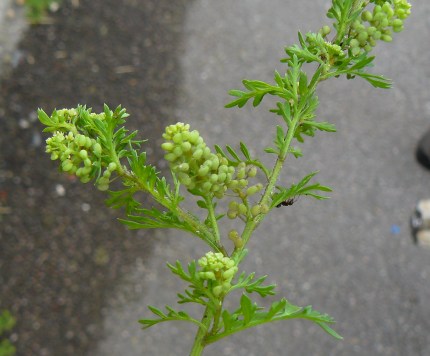
I found my first open
Spear Thistle flower of the year open on the
east side of Peter Pond. What a cracking flower it is
too.
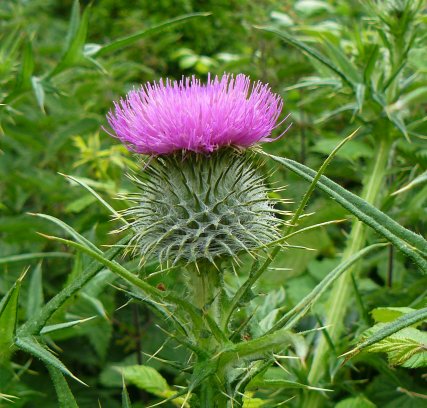
I happened to meet
Paddy who lives in The Rookery. She is still feeding
the Hedgehog in her garden that she said did
not hibernate at all over the last very mild winter
and is looking fine.
Brook
Meadow
Coming back
through Brook Meadow I checked the Blue
Water-speedwell plants on the edge of the Lumley
Stream which are now showing the long flower spikes
characteristic of the hybrid (Veronica x
Lackschewitzii) with Pink Water Speedwell.
Martin Rand says the hybrid is much commoner than
either parent on most streams of central and eastern
Hants. We already have a number of records of the
hybrid from Brook Meadow. Here is a rather poor photo
of a flower stem showing plenty of flowers.
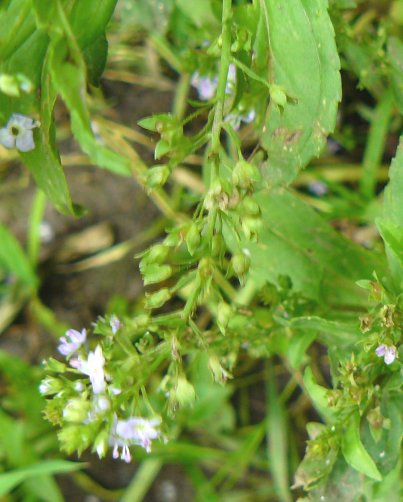
I got a very nice
close-up photo of a female Demoiselle resting upside
down on a leaf. I think it is a Beautiful
Demoiselle which my guide says has broader wings
with a brownish tint; the female Banded Demoiselle has
a greenish tint to narrower wings.
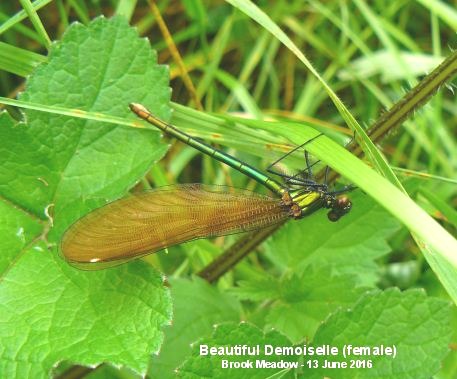
SATURDAY
JUNE 11 - 2016
Beachlands,
West Hayling
Jean and I went down to Beachlands on West Hayling
this morning mainly to look for Dodder which I
hear is out in some areas of the country. I last saw
this unusual parasitic plant on the Gorse on
Beachlands in July 2011. We looked around the pitch
and putt golf course area which is where I think I saw
it last time, but we could not see any. Maybe we were
too early?
Here is a photo that I took last time of the plants
crawling all over a Gorse bush. As you can see, it
consists of tangles of red thread-like stems and
clusters of tiny pale pink flowers. It has a very
unusual life history which I won't go into here, but
which you can read about in the flower guides or on
the web.
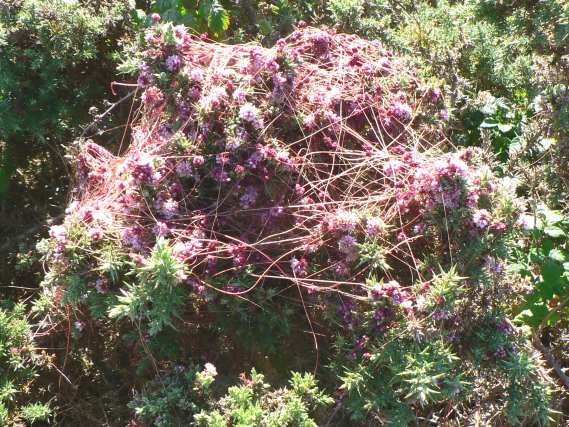
Despite missing out on
the Dodder, we enjoyed our visit and saw lots of other
nice flowers including masses of English
Stonecrop along the path edges, patches of pink
Thrift, White Bryony twining over the
bushes (a bit like Dodder), and the very pretty pink
and white striped flowers of Field Bindweed. We
also noted a few spikes of Viper's Bugloss and Weld.
The only birds that
caught our attention were the Linnets that
flitted around the bushes. One perched high on a
bramble which I got a photo of. The absence of red on
forehead suggests a female, though the russet breast
indicates a male. Maybe it is a juvenile male?

Chidham
meadow
Tony Wootton
walked from Nutbourne towards Chidham yesterday at
about 18.00 and came to what is called an 'alternative
path'. He says this was created a few years ago so as
to avoid going around the very crumbly coastal path.
It goes directly across a meadow which is full of wild
flowers, including Common Spotted, Pyramidal and Bee
Orchids Broomrape, Wild Carrot (just opening) and what
must be the first Meadow Brown butterfly of the year.
Here are some of Tony's photos.
FRIDAY
JUNE 10 - 2016
Warblington
Bee Orchids
This morning I
took my life in my hands to rush across the very busy
A259 road just before the Warblington roundabout to
see if any Bee Orchids had survived on the northern
roadside verge. Here is a view of the northern verge
on the A259 looking west towards the Warblington
roundabout.
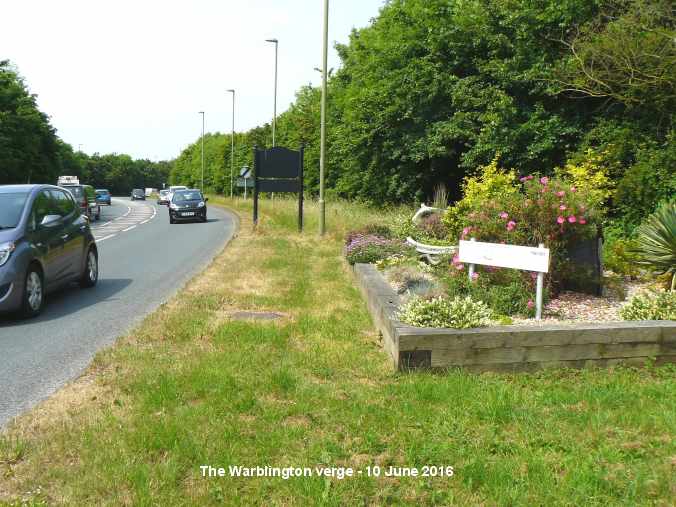
At this time last
year, Di Ashe found over 50 flowering Bee Orchid
flowers, but they were all cut down in their prime by
the Council mowers shortly afterwards. However, when
Jayne Lake (of HBC now Norse) and I checked the verge
on Mar 23 this year, we found some plants had survived
and were showing leaves. So, Jayne issued instructions
for the mowers to give the orchid area a miss when the
next cutting was due. But, the message did not get
through and these poor plants were once again
subjected another blast from the cutting machines in
early May which almost finished them off.
But, no, still some have actually survived! Against
all my expectations, I managed to locate 7 flowering
Bee Orchid plants on the far end of the grass verge
near the slip road from the A27. I could not push the
dead twigs into the hard ground, so I laid a few
sticks around the flowers to mark the site. This photo
shows a little group of three flowering plants on the
roadside verge.
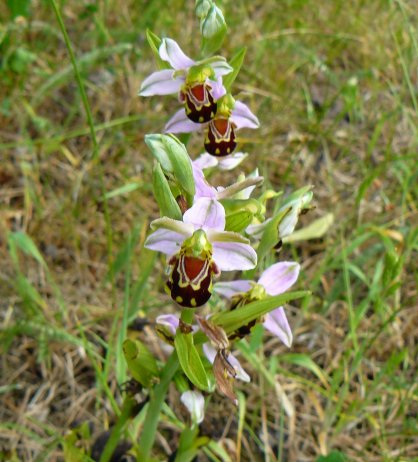
Although the Bee
Orchid flowering has been severely affected by the
mowing of the verge, I am advised by experts that the
orchids should be back again next year, provided the
present flowers are allowed to set seed. Let's hope
the message gets out to the cutting teams next year to
avoid this sensitive verge until after the end of the
flowering season. Please don't cut them again!
Ironically, much of
the rest of the grass verge has been left uncut with
the result there is a fine swathe of grasses and wild
flowers which are looking very good. Among the plants
I noted were the first Common Ragwort flowers
of the year and a mass of Caper Spurge near the
ornamental boat. I only came across Caper
Spurge for the first time ever yesterday on the
east side of Peter Pond. Here are these two plants on
the Warblington road verge.
Warblington
wayside
While I was
there, I also had a look at the 'official' wayside
which is where the path and cycleway goes down to the
underpass. The centre verge where Clustered Clover
used to grow was closely mown as was the northern
embankment, but most of the other areas were uncut. I
logged a total of 95 different species which is about
average for this very flower rich area. The area along
the track towards the Pressure Reducing Station was
particularly rich in wild flowers. It was here I found
Toad Rush (new to this wayside), Creeping Bent (first
of the year) and possibly Squirrel-tail Fescue which I
have seen in previous years.
Also on the
wayside were: Selfheal - newly flowering and Timothy
grass - first emergence of spikelets
Rose-ringed
Parakeets
Chris Oakley
has had two reports of Rose-ringed Parakeets (aka
Ring-necked Parakeet) seen locally. One was from the
top end of New Brighton Road and the other of a pair
at the top end of the new estate toward Long Copse
Lane. Could be the same ones, of course. These
attractive birds are fairly common in the London and
Surrey areas, but rarely come down this way. If you
have heard or seen them please let me know. This is
what they look like and are they are quite noisy!
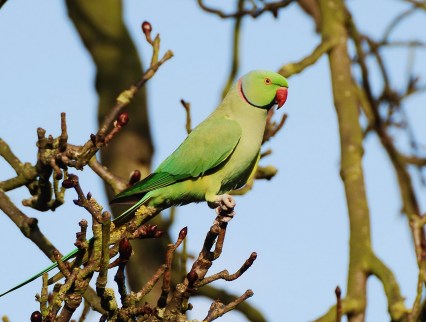
Langstone
Mill Pond and Southmoor
Late in the
morning Peter Milinets-Raby popped down to Langstone
Mill Pond and then walked over to Southmoor to
photograph the Southern Marsh Orchids (11:55am to
1:20pm).
Langstone Mill Pond: A pair of Shelduck were at the
back of the pond - very wary. The male was on look out
for the female whom was feeding with lots of upends.
Also on the pond were 2 male Tufted Duck (I hope the
females have settled on eggs now), the regular pair of
Gadwall were still busy feeding and there was just one
singing Reed Warbler.
I counted 61+ Little Egrets (two quite old youngsters
visible and one nest had a pair of tiny chicks -
cute!). There was a young Grey Heron in the Top Holm
Oak nest flapping its wings vigorously (second
brood).
Off shore (low tide) was another single Shelduck and 2
Great Crested Grebes as well as 2 Med Gulls flying
over. Not even an Oystercatcher today!
Birds on Southmoor included 3 singing Cetti's Warbler
(so noisy), 2 Lesser Whitethroats singing, 1+
Whitethroat, 2+ Meadow Pipit, a Green Woodpecker and a
Skylark. Find attached my best Southern Marsh Orchid
photo from Southmoor - such a lovely plant in close up
(taken with my new clip-on macro lens for Samsung
Mobile Phone camera - nifty gadget). I am finding the
mobile phone camera better than my proper
camera!!
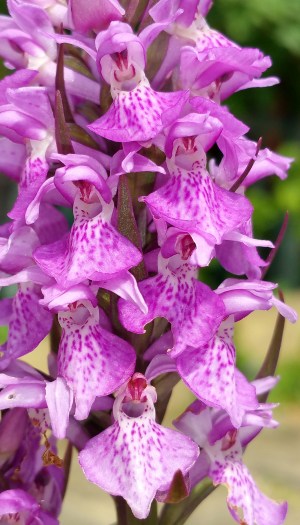
PS Has anyone else had
experience of using a macro lense with a smart phone?
I think Apple also do one for the iPhone. Looks
promising, though I gather it does not work if you
have a cover on the phone.
THURSDAY
JUNE 9 - 2016
Brook
Meadow and Peter Pond
I had another look at the possible Water Vole
burrows on the river bank in Palmer's Road Copse, but
there was no sign of any activity. I also checked the
Lumley Stream for Water Vole but saw nothing. I met
Brian Lawrence on a similar quest, but he also drew a
blank. But we must persevere! Brian later got a nice
photo of a male Banded Demoiselle - which has
been unusually scarce so far this year on Brook
Meadow.

I headed to Peter Pond
where I heard at least two Reed Warblers
singing merrily. The one in the reedbeds in the south
west corner of the pond appeared to have a mate as
there was much chasing around in the reeds. Rather
than singing, the male often made churring calls,
presumably to attract the female. One is very close to
these birds, but they are always deep in the reeds and
hard to photograph. This was my best
effort.

I noticed Hairy
Tare was in flower in the regular spot by the pond
on the path to Gooseberry Cottage. This is the only
spot I know of locally that this plant grows.
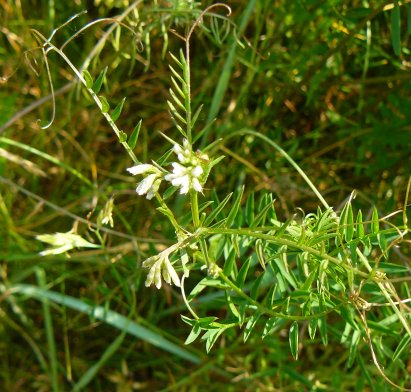
Guided
walk on Brook Meadow
This afternoon
I was pleased to lead a walk through Brook Meadow for
about 15 members of the SW Natural History Society
which is based in Devon. They had previously visited
Emsworth on 25 May 2009 when we had the vast invasion
of Painted Lady butterflies, but there was nothing as
exciting as that today. In fact, we saw we few
butterflies during the whole afternoon. However, we
did see lots of other interesting things, including
wild flowers, grasses and sedges. Jennifer Rye met the
group in Palmer's Road Car Park at 2pm and gave an
introduction to Brook Meadow and the work of the
conservation group.
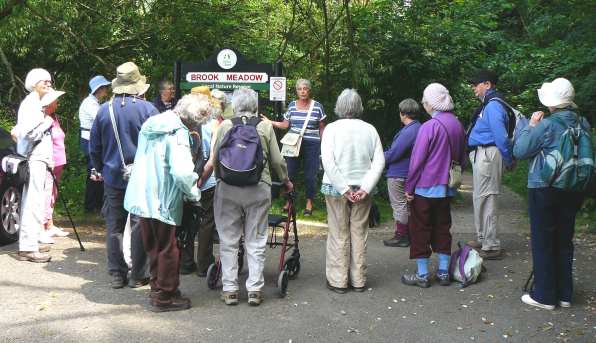
Jennifer took a group
photo - with myself in it for a change!

When Jennifer had
finished I took the group onto the south meadow where
we examined the unusual Hairy Buttercups and
Celery-leaved Buttercups, which were new for some
members.

We made our way to the
Lumley area where I pointed out Divided Sedge which
was primarily responsible for the meadow getting its
SINC status. We also looked at some of the other
sedges and grasses along with the Ragged Robin and the
Bee Orchids which attracted great attention.
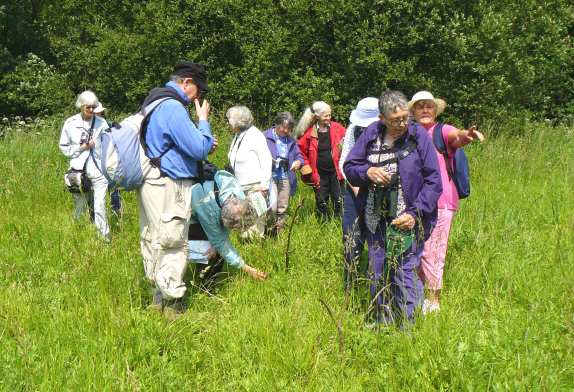
The group were also
very impressed with the main orchid area with its rich
variety of wild flowers, including Southern Marsh and
the Common Spotted Orchids.
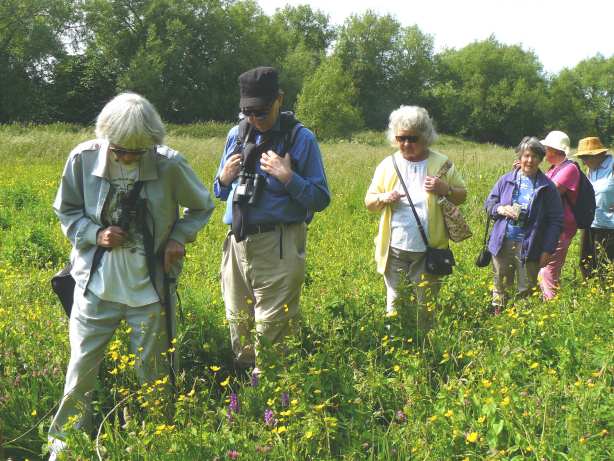
I was thanked by the
group for leading the walk on such a lovely afternoon.
A donation was made to the conservation group.
Caper
Spurge
I had several
replies to my query about the mystery plant on the
east side of Peter Pond in yesterday's blog. My thanks
to Ralph Hollins, Jill Stanley, Ros Norton and many
others. They all agreed that it was Caper Spurge
(Euphorbia lathyris).
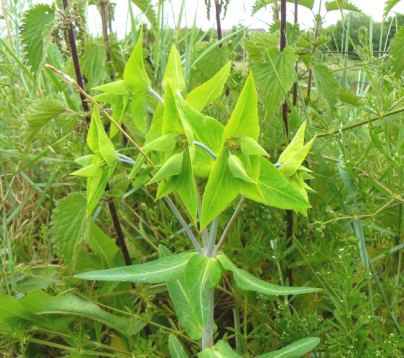
The fruits resemble
capers but are poisonous. It is also known as Mole
Plant as it is said to deter Moles from entering a
garden in which it is planted. The sap can be
irritating, particularly if it gets in the eyes. So,
it is best left alone! One respondent said in the old
days beggars used to rub it on their faces so that the
resulting blisters would incite more pity from
passers-by. It is widespread as a garden escape,
especially young plants, which is what I saw on Peter
Pond.
Guard
Squirrel
Chris Oakley
set up an old Robin nest box as a peanut feeding
station in his garden for the local squirrels. He
says, "Just
lately the young Great Tits have discovered this and
are more than pleased to have found this new source of
feed. One of the squirrels has taken to sitting in the
box, which is half full of nuts as if protecting it
from marauding birds. How he manages to squeeze in I
haven't seen. He usually does it early morning and
late evening when the birds are about. He doesn't
appear to eat while on guard but is constantly on the
twitch, looking up and down as if prepared to see off
the small birds."

Titchfield
Haven
Tony Wootton
got this great action photo of a Black-headed Gull
chick being snatched by a Lesser Black-backed Gull.
Tony thinks the chick may have survived the attack as
the other adult gulls forced it to be dropped, but he
didn't see the outcome of its landing.
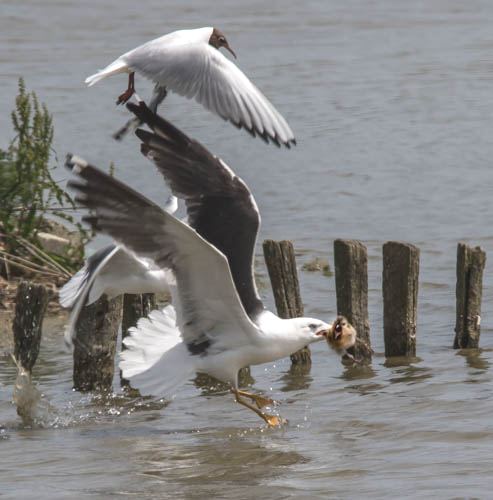
WEDNESDAY
JUNE 8 - 2016
BROOK
MEADOW
It was a warm
and sultry morning for my regular walk around the
meadow.
Orchids
First I
checked the orchids. The group of 5 Common Spotted
Orchids to the north of the main orchid area are
looking very healthy as is other one nearby. The other
Common Spotted Orchid on the main area is very small.
The total is still at 7.
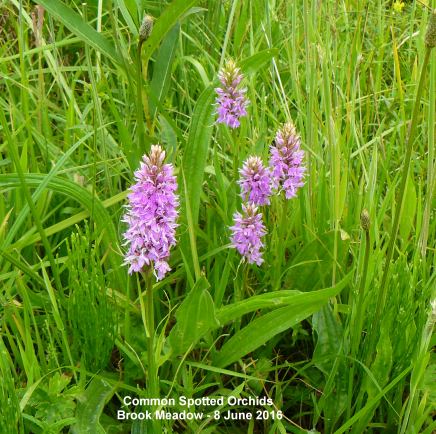
I did not count the
Southern Marsh Orchids, but there were 21 at the last
count. I looked in vain for any more Bee Orchids. I
bet there are some there, but they will be so
difficult to find in the long grasses. Currently we
have 6 marked on the Lumley area.
Water-speedwells
I am a bit
puzzled by some the plants growing in the mud on the
edge of the Lumley Stream which Jill Stanley
tentatively identified as Blue Water-speedwell on May
30. At the time I thought they were more likely to be
Brooklime, but now I am not sure. The flower spikes
are relatively short and the flowers pinkish. This
suggests Pink Water Speedwell which I have not seen on
Brook Meadow since 2007.
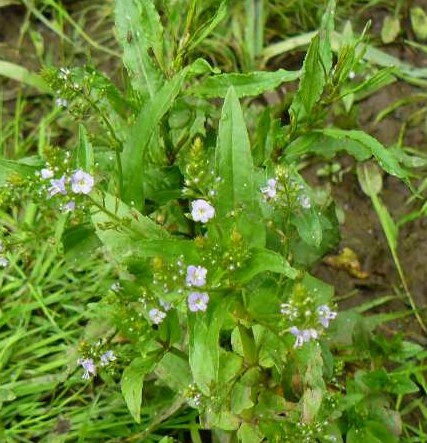
Also, there is a good
patch of definite Brooklime on the new buttercup path
on the east side of the south meadow, which is quite
different from the Lumley Stream plants. In addition,
while mooching around on the west bank of the river in
Palmer's Road Copse I came across some plants which
looked far more like Blue Water-speedwell with fairly
long spikes and blue flowers. I shall need to look
again at these plants.
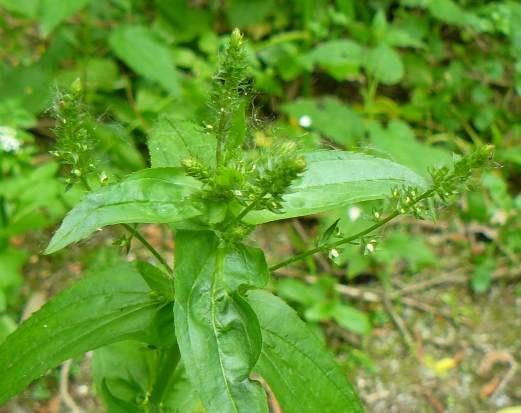
Water
Voles
I watched for
a possible Water Vole from the bank of the Lumley
Stream for about 10 minutes, but saw nothing. However,
I did notice what looked like fresh burrow holes on
the east bank of the main river in Palmer's Road
Copse. I could almost see the claw marks made by the
voles. They can be seen from the open area on the west
bank near to the Deep Water sign. Again, I watched for
a few minutes, but nothing moved, but I shall return.
This looks promising.
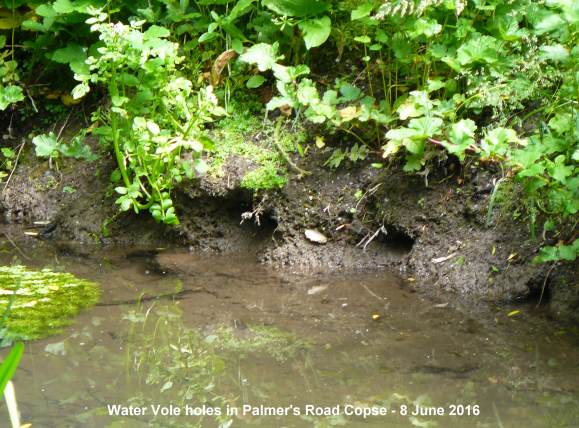
Birds
On the bird
front all three of our summer visitors are still
singing on the meadow, Chiffchaff, Blackcap and
Whitethroat. There must be at least two of each and
probably more.
Peter
Pond
I came across
a couple of mystery plants on the east side of Peter
Pond almost opposite the house called 'Brook' on
Lumley Road. I thought at first they were Prickly
Lettuce, but on closer inspection that clearly was not
the case as there were no prickles. The plants had
tall straight stems with long and pointed lanceolate
leaves and what appeared to be a complex flowering
head sprouting at the top. The left hand photo shows
the whole plant while the one of the right shows the
sprouting at the top.
Also in the east side
of Peter Pond, there is a very nice flowering of what
I think is Red Fescue right beside the concrete
outflow from the small brook that runs beneath the
road into the pond.
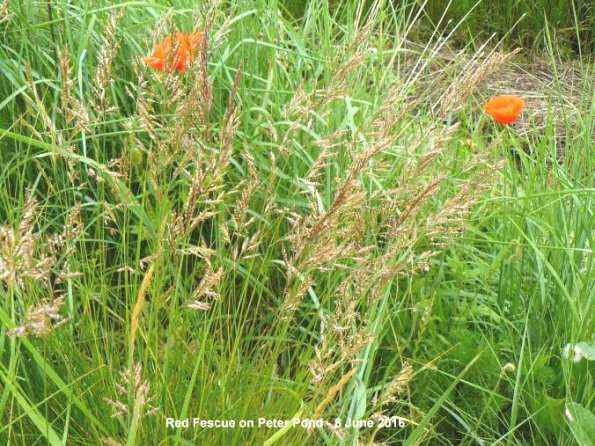
The grasses had the
distinctive sharp angled single leaf sticking out from
the stem which I always look for in Red Fescue.
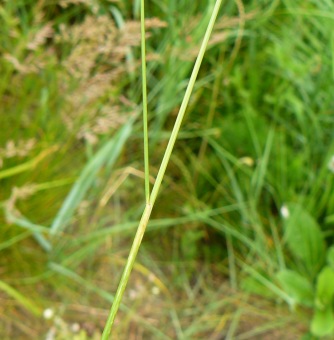
Slipper
Millpond
Coots are
nesting again on both the north and the south rafts
for a second time. I have seen nothing of the first
brood of Coot chicks which were probably taken by the
Great Black-backed Gulls.
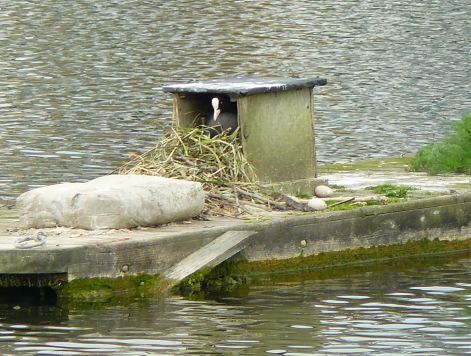
The three Great
Black-backed Gull chicks were on the centre raft
with one of their parents, the other parent being on
the water nearby. The chicks were taking a drink while
I was present, were growing and looked healthy.
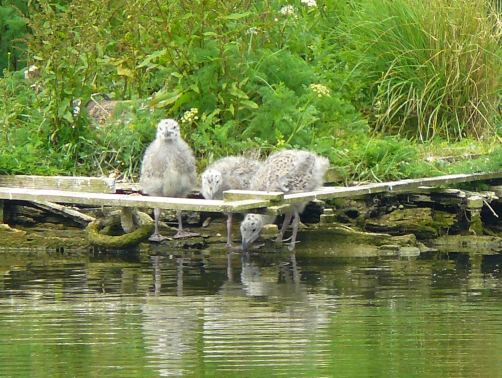
For the history of the
nesting Great Black-backed Gulls see . . . .
Great
Black-backed Gulls nesting
TUESDAY
JUNE 7 - 2016
Southmoor,
Langstone
Following Tom
Bickerton's failure to see the Southern Marsh Orchids
at Southmoor over the weekend, I decided to go myself
just to make sure the orchids were still there! There
are usually several thousand of them and last year's
official count came to 7,786 on June 29. Parking at
the end of Southmoor Lane I was greeted by the song of
a Cetti's Warbler from the hedgerow. There was
also a clump of Pink Sorrel close to the
parking bay, pretty but an escape.
I made my way through the entrance gate onto the
Hampshire Wildlife Trust reserve and along the narrow
path to the main moor. If you wish to see the orchids
it is necessary to clamber over the stile next to the
gate which is pretty easy even for someone of my age!
This takes you onto the main orchid area, but please
take special care where you tread so as not to damage
the plants.
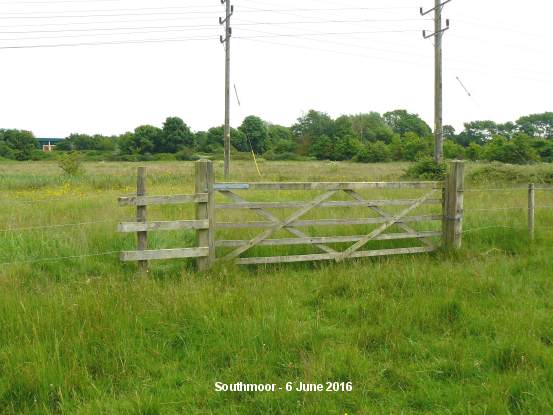
There are in fact
plenty of Southern Marsh Orchids in flower on
the moor, though it is still a bit early for them as
many are still small and hardly open. Here is one of
the more mature ones that I got on camera.
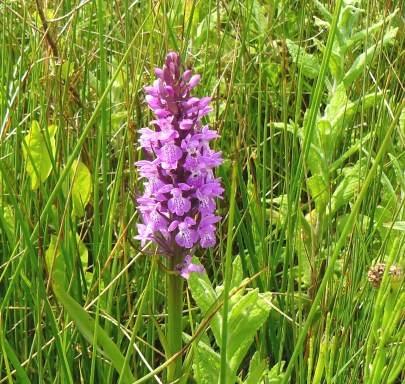
Fortunately, the moor
was pretty dry and my normal shoes were fine, though
the vegetation is tall and walking is not easy. It is
best to follow one of the casual paths. I will not
list all the plants I saw, but there is a lot to there
see.
The moor is very good for sedges, including lots of
Divided Sedge, False Fox Sedge, Common Spike-rush and
what I am fairly sure is Black Sedge which I
usually find on Southmoor. The feature I always look
for in Black Sedge is the very long lower bract and
this is shown well in this photo. Another nice plant
on Southmoor is Compact Rush with its tight
cluster of spikelets.
Another plant I look
forward to seeing on Southmoor is Marsh Horsetail
with its very distinctive cone at the top of the
stem. This is quite different in appearance to Field
Horsetail which we have on Brook Meadow and Great
Horsetail which is the plague of my son's allotment on
the Isle of Wight.
I was also pleased to see Marsh Thistle in
flower, a really handsome plant and very attractive to
insects, though I did not see many today. In fact, I
saw no butterflies at all. Where are they all?
I was interested to
see a few plants of what might be Large
Bittercress with particularly large white flowers.
Unfortunately, my simple camera did not cope well with
these flowers, so no photo. Grid Ref: SU 71242 05150.
However, in an other location, close to the large
poles holding the electric cables, I did find what I
am sure was a mass of Wavy Bitter-cress with
clusters of small white flowers. I checked the flowers
at home and they had the required 6 stamens.
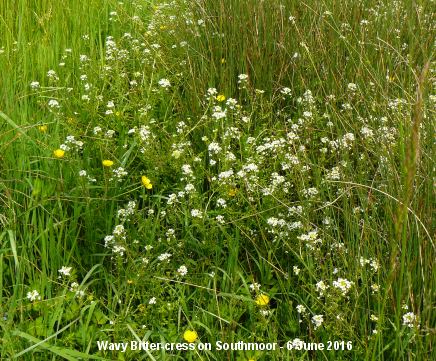
House
Martin survey
Caroline
French sent an up date from her House Martin survey in
Westbourne.
"Yesterday, I heard sounds of the first young of the
year coming from one of the nests I am monitoring. The
chirps sounded weak so I think they must still be very
young. I will try to get over again in a few days time
to see whether any of the other nests have young by
then. Of the 13 nests I am monitoring, 1 now has
young, 9 have adults apparently incubating eggs, 1 is
an old half-built nest which no House Martins have
shown any interest in this year, 1 is a quarter-built
nest - again no interest shown by birds. The final
nest is a bit of a mystery: it is a new nest this
year, alongside 3 other old nests on the same
building, and is so far a small mud-cup, about a
quarter-build. However, the House Martins seem to
disappear into a recess under the eves, above and
behind the mud cup, more the way you would expect
House Sparrows or Starlings to do. I'll be watching
this with interest! One of the locals told me that
there was a great number of House Martins feeding over
the river in River Street, Westbourne a few days ago.
He said it was a wonderful sight - people were taking
photos"
PS If you have any photos of House Martins please let
us have them.
Langstone
Mill Pond
Yesterday,
Peter Milinets-Raby popped down to Langstone Mill Pond
(1:53pm to 3pm) walking in from Wade Lane. The
highlights were as follows: Blackcap still singing, 6
Swallow, pair of Pheasant, 2 Stock Doves.
Langstone Mill Pond: Shelduck on pond - first I
have seen this species on the pond (reported on your
web site earlier). The bird was very wary and kept to
the rear of the pond and was whistling frequently.
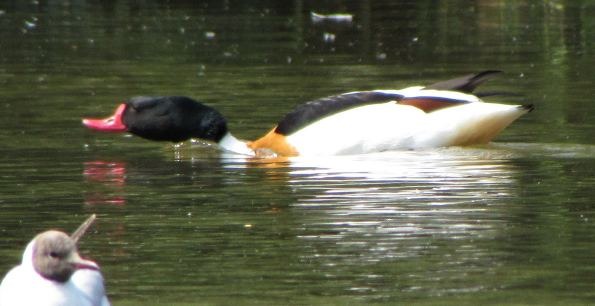
A few days ago there
were 5 Shelduck off shore - two clearly paired up. 3
pairs of Tufted Duck and a pair of Gadwall (I was
hoping that these would have bred!). Chiffchaff still
singing, 3 Reed Warblers singing, Mallard with 5
ducklings and another bird with 4 ducklings.
Moorhen with five juveniles (see most boring
bird photo in the world).
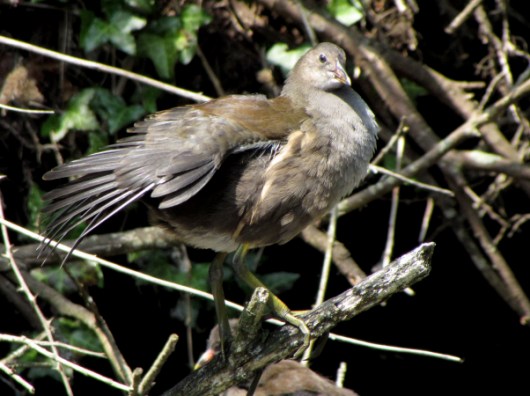
2 Mute Swan on the
pond. Not the resident pair. I wonder if they are
young from last year. They were off Conigar Point a
couple of days ago. 65 Little Egrets counted - a
couple of nests held small chicks. Off shore - High
tide: 2 Sandwich Tern, 3 Common tern, 1 Med Gull.
Other
news
We have had
four Swifts flying over Bridge Road at various
times today. They are flying lower down and screaming
quietly. So, this looks more promising.
Brian Lawrence had a couple of Painted Ladies
in his front garden and a Holly Blue in the
back garden.
Brian also had this
very attractive Mullein Moth caterpillar.
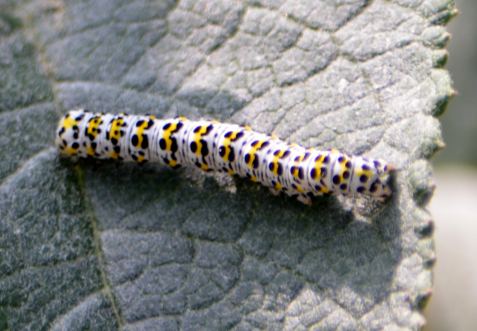
My neighbours from across Bridge Road, John and Anne
Williams sent me some photos taken with their night
camera showing two Hedgehogs were visiting
their garden last night.
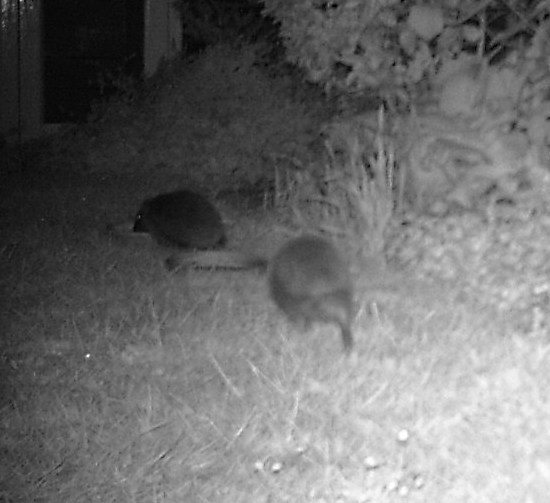
Eric Eddles got this shot of a very obliging Reed
Warbler at Baffins Pond. He has seen them at the
pond before in 2013 and 2014. Nice one, Eric!

MONDAY
JUNE 6 - 2016
Brook
Meadow orchids
I went over to
the meadow this morning with my wife Jean and our
grandson Joe, whose school has an inset day, to have a
look for the new orchids that Maurice Lillie found
yesterday. We found the four Southern Marsh
Orchids in long grass closer to the Osiers than
others. That brings the total so far to 21 including
the three spikes on the Lumley area, thus topping last
year's record by one. More to come maybe?

This chart shows the
counts of Southern Marsh Orchids on Brook Meadow since
2007.
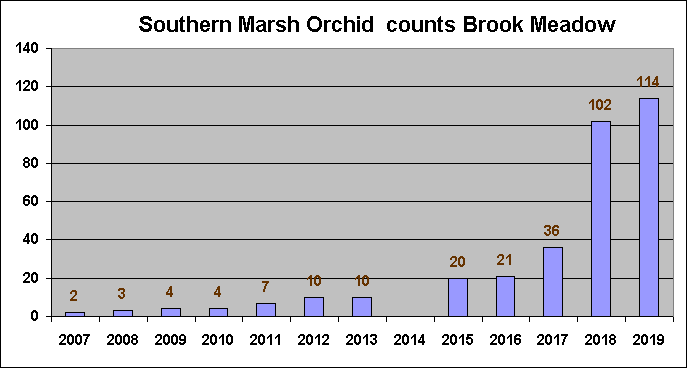
The first two Southern
Marsh Orchids were planted on Brook Meadow on June 17,
2007. They were donated by orchid expert Nigel Johnson
who had grown them in pots from originals collected
from the colony on South Moor at Langstone. Nigel said
the plants would seed themselves and would multiply
over time and he was right!
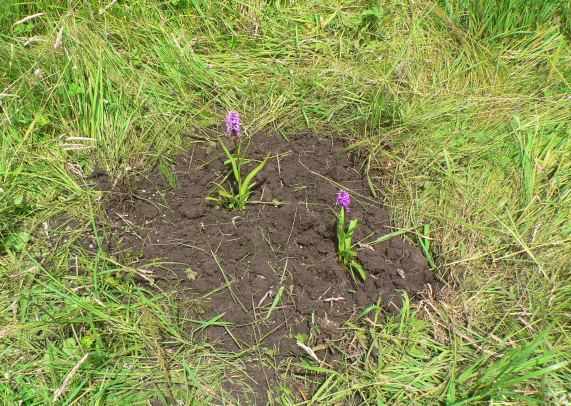
We looked at the cluster
of 5 Common Spotted Orchids to the north of the
main orchid area and found another one nearby. Then we
found another one in the south west corner of the main
orchid area at Grid Ref: SU 75065 06111. This takes
the total to 7 which is the same as last year's record
total.
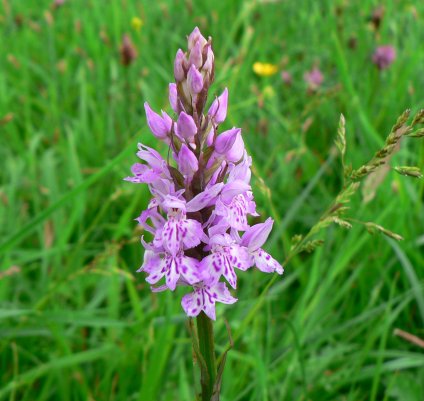
This chart shows the counts of Common Spotted Orchids
on Brook Meadow since 2007.
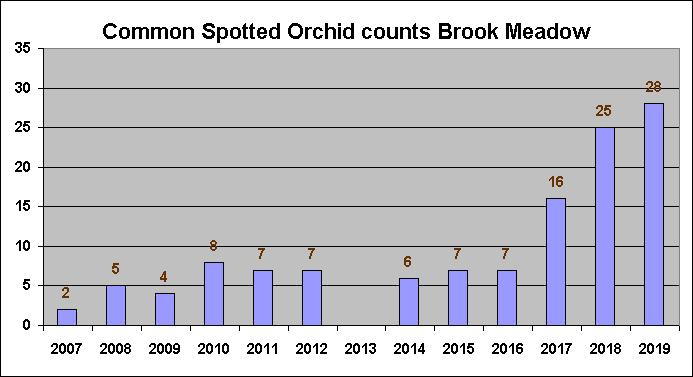
We went over to the
Lumley area where we easily found the 4 Bee
Orchids that were discovereed yesterday on the
Lumley area by Maurice thanks to his marking of them
with tall sticks - at Grid Ref: SU 75131 06038. We
found another 2 Bee Orchids close by which we marked
with twigs. We now have 6 Bee Orchids on the Lumley
area, no doubt with more to come. Last year's record
total was 29. Here is one of Maurice's excellent
images of the Bee Orchids taken yesterday.
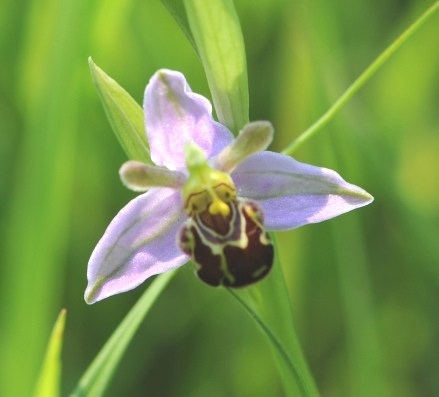
This chart shows the counts of Bee Orchids on Brook
Meadow since 2007.

Tom's
news
Over the
weekend, Tom Bickerton went to see the Southern Marsh
Orchids at Southmoor, but strangely did not find them.
He must have been looking in the wrong place as there
are usually thousands of them there. Tom then went
over to Northney and counted 17 Bee Orchids
near the new Owl box. Here is one of them. They are
popping up everywhere just now.
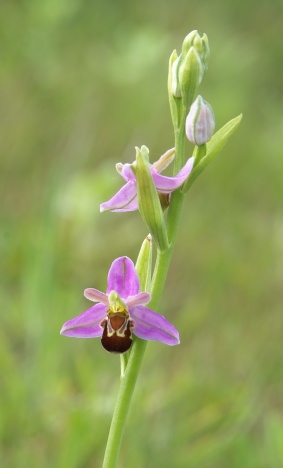
Tom also went to Iping
Common, where he got this excellent image of a
Four-spotted Chaser dragonfly - named after the
spots in the middle of each wing. I have never seen
one of these; they look a bit like the more common
Broad-bodied Chaser, but with a much thinner body.
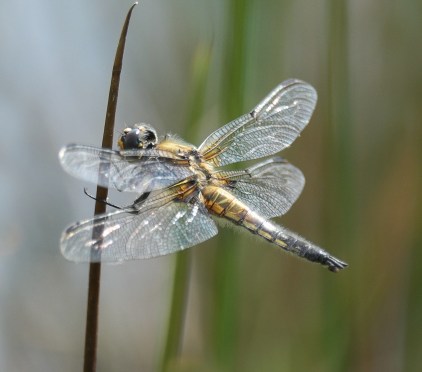
Hedgehog
and Fox in garden
Graham Petrie
has some Hedgehog and Fox footage from his Havant
garden. Here are links to videos on Facebook.
https://www.facebook.com/graham.petrie/videos/10209873838066915/
https://www.facebook.com/graham.petrie/videos/10209873880467975/
Other
local news
David Minns
saw two pairs of Swifts above the North St area
in Emsworth yesterday evening 5th June. David says
they were definitely pairs, but flying high and not
looking as though they were nesting. The Hampshire
Swifts site doesn't seem to want records like this,
only nest records.
More evidence of a
mini invasion of Painted Lady butterflies came
from Tony Wootton who also saw his first at Wisley
yesterday and says another was in a neighbour's garden
in Highland Road, Emsworth.
SUNDAY
JUNE 5 - 2016
BROOK
MEADOW
Conservation work
It was a warm
sunny morning for the regular first Sunday in the
month conservation work session on Brook Meadow
attended by 13 volunteers. I was there to give advice
and take photos, not to work! Jennifer Rye discussed
the main tasks which included some mowing of certain
areas with the new power scythe and raking up
arisings. I suggested giving the new experimental wild
flower areas in the north meadow a cut to give the
seeds sown last autumn a chance to show themselves. At
present they have no chance against the resident
grasses. Here is a shot of Maurice mowing one of these
areas with the new scythe.

The old Bramble path
on the east side of the south meadow was also mown to
open it up to visitors, carefully avoiding the new
buttercup path that has appeared in the flood defence
area immediately adjacent to the Gooseberry Cottage
garden bund. Here is a view of the path showing the
abundance of Celery-leaved and Hairy Buttercups.
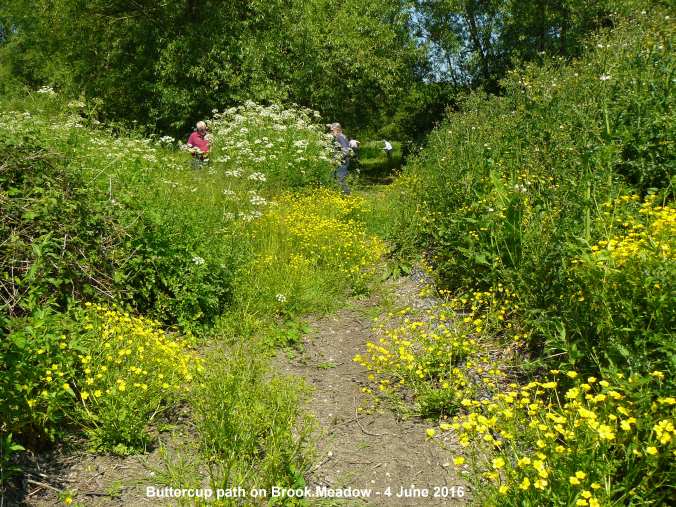
For the full workday
report with more photos go to . . . http://www.brook-meadow.hampshire.org.uk/bm-diary-current.html
Painted
Ladies
During the
work session I was pleased to meet two visitors to the
meadow from Havant - John and Lindy. As we were
chatting we watched a Painted Lady butterfly flying
past. It did not stop, but it was unmistakable with
its light brown colouring and strong flight. Robin
Pottinger had told me previously that he had seen one
in his Southbourne garden. Then, this afternoon, I had
one flying around my back garden, feeding on the Red
Valerian flowers. It must have been here for over an
hour so I managed to get some nice photos of it.
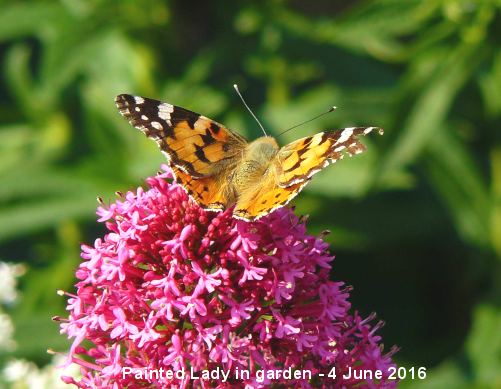
Painted Ladies are
migrant butterflies that cannot over winter in the UK.
Today's insects will be late arrivals from the normal
spring migration from the Continent. I wonder if we
shall have another mass invasion like in 2009?
Bee
Orchids
I looked for
Bee Orchids this morning but did not find any.
However, Maurice Lillie returned to the meadow this
afternoon and found four Bee Orchids on Lumley flower
area. He has marked them with three sticks in a row
and one to the west. All are near the Poplar tree that
is nearer the Lumley Stream. Here is one of Maurice's
many photos of these lovely flowers.

Maurice also found 2
pairs of two Southern Marsh Orchids in the
north meadow flower area which I am sure have not been
recorded before. They are in long grass closer to the
Osiers than others. Maurice has put sticks to mark
them.
Swifts
Two Swifts
were flying over the houses in Bridge Road at about
8am this morning, but I did not see them again. Swifts
are very scarce this year. Has anyone seen any?
Eel
catch
Ralph Hollins
responded to my query about how a Great Black-backed
Gull could have possibly caught the large Eel that it
brought back to feed its chicks on Slipper Millpond on
June 3.
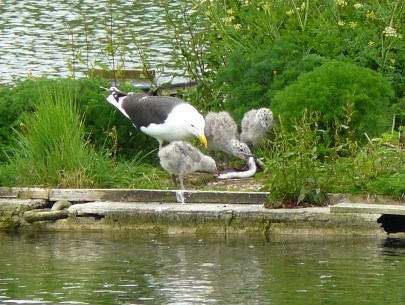
Ralph says, "I would
guess that it stole it from a Cormorant. The bird
(Heron or Cormorant) which catches an eel or other
slippery fish often has a struggle to get it from the
position (at right angles to its bill) in which it was
caught to the inline position in which it can swallow
it and the eel often escapes during the process only
to be caught again but not necessarily by the original
captor. I recall seeing an eel being caught in the IBM
Lake by a Cormorant, then stolen by a Heron, then
recaptured by a third bird."
Millpond
News
Chris Oakley
went on his usual walk around the harbour this morning
and found that the Mallard on the town millpond still
had 8 ducklings; she had 11 when Chris saw them on May
22. He says, today one of the swans appeared to be
trying to separate one duckling from the others, so
the prospects for that one would not seem to be good.
However, they have done remarkably well to have
survived this long.
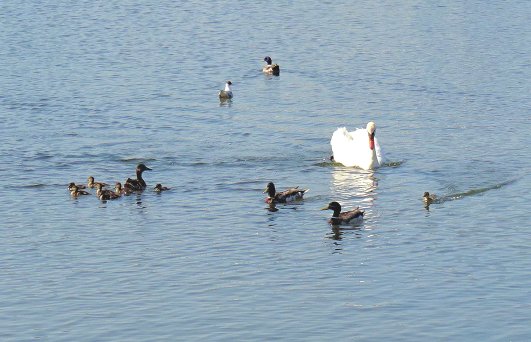
Starling
mayhem
Frank Naylor
hung a fat coconut from the washing line to stop the
squirrels stealing it. Then about 30 Starlings turned
up mainly fledglings and it was total mayhem. Here is
one of Frank's pics of the battle!
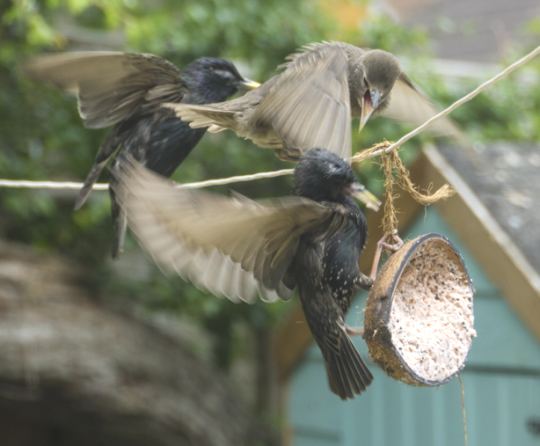
SATURDAY
JUNE 4 - 2016
Brook
Meadow
I spent a very
interesting couple of hours on the meadow this
afternoon in what must have been the hottest day of
the year. Summer at last! Fluffy seeds from the many
Crack Willow trees were floating everywhere, rather
like gentle snowflakes and settling in tiny drifts in
crevices. That was nice to see, but I was a little
saddened to find the splendid avenue of Cow Parsley
which was in the peak of its flowering along the main
river path from the north bridge had been mown flat by
the council workers. We (the conservation group) need
to ensure that this fine spectacle remains uncut in
future years until after the main flowering.

I had a quick look at
the experimental wild flower area on the north meadow,
but alas, the locally sourced seeds sown by the
conservation group last autumn have, as I expected,
been totally submerged under an explosion of resident
grasses, such as, Tall Fescue, Yorkshire Fog,
Cocksfoot and Rough Meadow-grass - which in fact are
looking very good! I was pleased to find some
Silverweed with yellow flowers open. Although
the silvery leaves of this plant are very common on
the meadow, I rarely see its flowers.
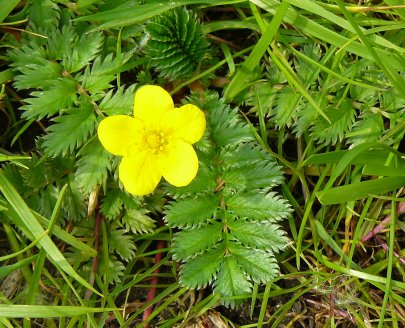
Other plants starting
to flower included Hedge Woundwort, Creeping Thistle
and Wall Barley.
Orchids
The Southern
Marsh Orchids were looking very good indeed on the
main orchid area. I counted 12 of them - an increase
of 2 over the last count. Together with the 3 spikes
on the Lumley area this makes a total of 15. We are
getting closer to the record 20 spikes of 2015.
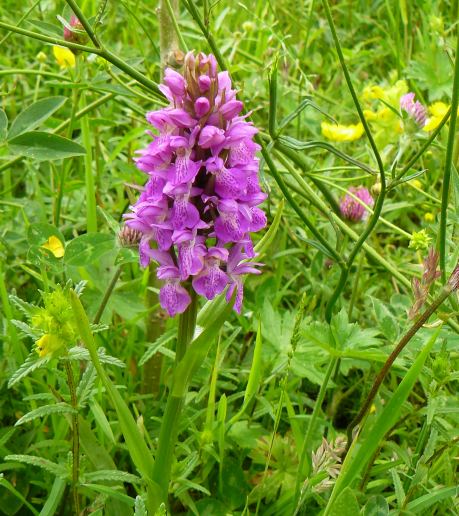
I also found the first
Common Spotted Orchids of the year in a small
group of 5 in the much the same place as they were
last year about 10 metres to the north of the twig
boundary around the main orchid area at Grid Ref: SU
75067 06158. I marked them with sticks as usual. Last
year we also had two more Common Spotted Orchids on
the main orchid area, but I could not find them today.

I looked for Bee
Orchids both of the main orchid area and on the
Lumley area, but saw nothing. They will not be easy to
find as the grasses grow. Last year we found 25
flowering Bee Orchid plants. Hope we get some at least
this year.
Insects
I saw several
ginger Bumblebees feeding on the Yellow Rattle
flowers, but no sign of any butterflies. Where are
they? In contrast, there were lots of little white
moths fluttering around the orchid area. We get them
every year at this time; they are called Grass
Rivulets and their larvae feed on Yellow Rattle.
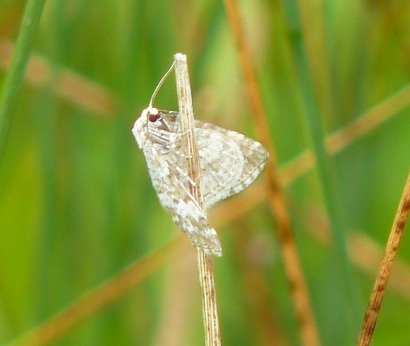
Water
Vole
Keeping the
best to last, while perusing the plants on the side of
the Lumley Stream, I spotted what looked like a really
fresh Water Vole burrow hole on the east bank. Almost
immediately, a Water Vole appeared, swimming
downstream and stopped on the bank outside the hole. I
was in luck. This was my first Water Vole of the year.
It may have been the same animal that Carole
Checksfield & Paul Seagrave and Chris Akass had
seen from the Lumley Path footbridge at the north end
of Peter Pond, although this one was some way north up
the Lumley Stream from the Lumley pool. Fortunately,
it remained on the bank while I gingerly got my camera
out and took a few snaps.
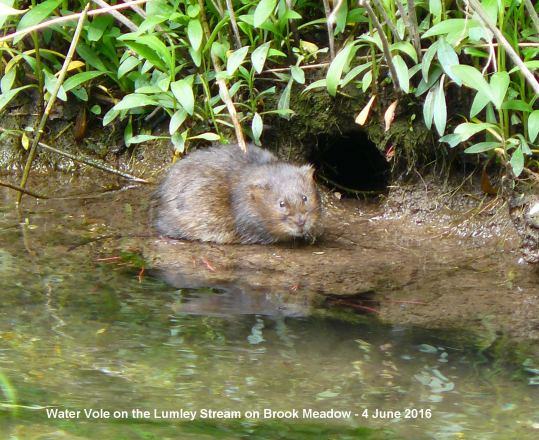
After a couple of
minutes, it swam a little way downstream and
disappeared into another hole on the same side of the
stream not to be seen again. Wow! I thought I would
never see a Water Vole again on Brook Meadow, but they
are definitely still here! Let's hope there is more
than one and they manage to breed. If so, then the
youngsters may well disperse across the meadow to the
main River Ems on the west side where we have lost our
original population.
For
all the news, history and photos of Water Voles on
Brook Meadow see . . .
Water
Voles
Waysides
News
I noticed a
tuft of Buckshorn Plantain growing beside a
drain on the roadside at the bottom of South Street in
Emsworth.
Another first was Nipplewort in flower under
the Beech hedge on Bridge Road.
On my way to Brook Meadow this afternoon I came across
a remarkably good crop of Water Bent growing on
the pavement on Victoria Road outside house numbers 34
and 36. This was the best I have seen anywhere. Why is
it called Water Bent as it grows nowhere near water.

Fort
Purbrook
Jill Stanley
went to Fort Purbrook this afternoon and saw probably
hundreds of Common Spotted Orchids. The
Pyramidal Orchids are also appearing and some
of them have opened, so it's going to be a good show
there again! Jill also saw plenty of Bird's Foot
Trefoil, Crosswort, and Germander Speedwell, some
Yellow Rattle, lots of Salad Burnet, and a Viper's
Bugloss.
FRIDAY
JUNE 3 - 2016
Slipper
Millpond
I had a quick
look at the Great Black-backed Gulls on Slipper
Millpond at about 1pm. All was quiet when I arrived
with the three chicks snuggled down in the vegetation.
As I watched, one of the adults arrived with a large
Eel. How on earth did it catch that? It proceeded to
regurgitate the Eel though it was clearly far too
large for the chicks to swallow. So the adult consumed
it him/herself and slipped into the water to help it
down. Here is the story in pictures.
Meanwhile the three
chicks went to the edge of the raft for a drink - be
careful little fellers otherwise you could meet the
same fate as your siblings last year.
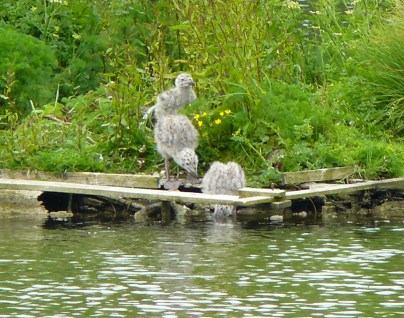
For
the full records with photos of the Great Black-backed
Gulls nesting go to
. . . Great
Black-backed Gulls nesting
Chichester
Peregrines
I went along
to have a look at the RSPB Peregrine watching station
in the Chichester Cathedral cafe garden this morning.
The live camera showed one of the four chicks making
one hell of a din, calling for food. I was told that
this is normal behaviour from healthy growing chicks.
They should be fledged in a week or so. Here is a shot
of the youngster in the monitor.
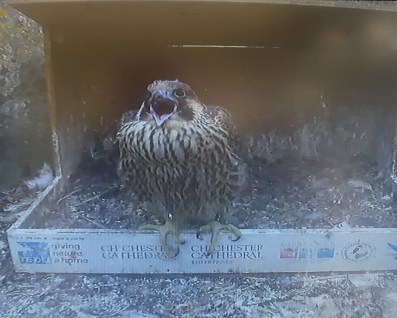
The volunteers had a
telescope aimed at the male perched on one of the
turrets above the nest so I got a digiscoped photo
using my phone. Not bad again.
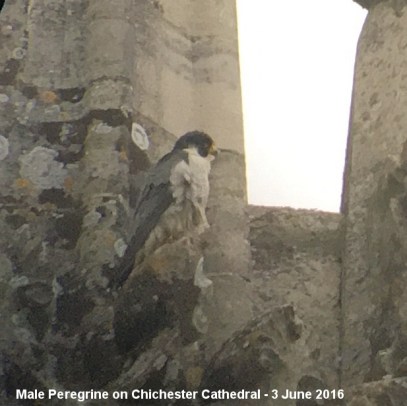
Garden
fledglings
Barrie Jay's
garden in Waterlooville is teeming with fledglings at
the moment. He has baby House Sparrows, Dunnock,
Goldfinch, Nuthatch, Great Tits and Blue Tits. Great
Spotted Woodpeckers are yet to show.
Damselflies
galore
Graham Petrie
has lots of damselfly action around his garden pond.
He thinks he has identified Common Blue, Azure, Large
Red and Blue-tailed. Can you sort them out?
THURSDAY
JUNE 2 - 2016
Waysides
News
This afternoon
I did a tour of a few of the local waysides on my
bike.
Canary
Grass
On my way up
Victoria Road I came across a tuft of Canary Grass
growing on the edge of the pavement next to house
number 3 which is currently empty. I last saw this
unusual grass in Emsworth several years ago in Bath
Road. It is distinctive in having oval panicles, a bit
like Hare's-tail Grass but much stiffer to the touch.
Rose describes it as a casual weed of waste ground and
rubbish dumps, often introduced through bird seed
mixtures, hence the name. It is native to the
Mediterranean region.
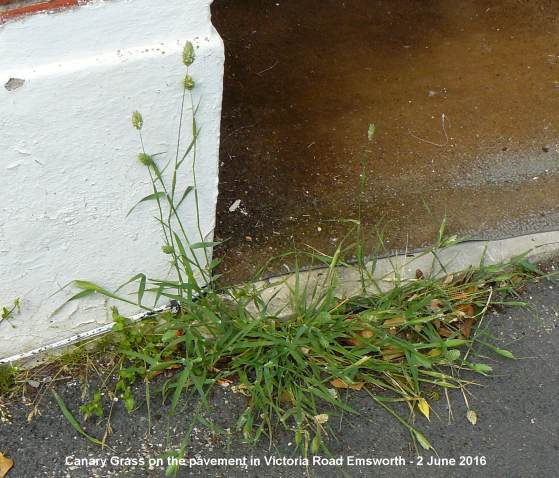
Railway
Wayside
The first
wayside I visited was the Railway Wayside to the north
of Emsworth Railway Station. Walking up the ramp I
found the first Hedge Woundwort flowers just
starting to open, but there was no sign as yet of
Marsh Woundwort which is a speciality of this site.
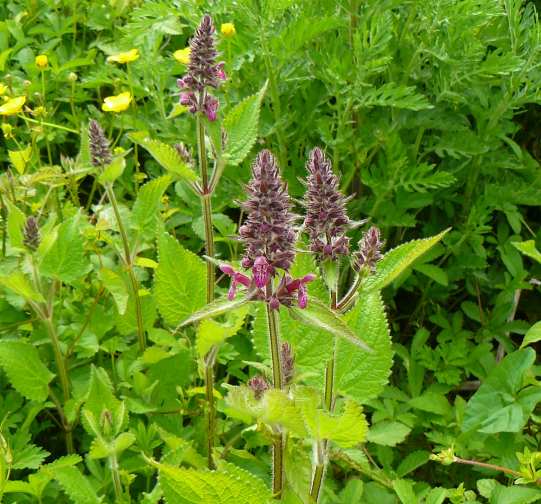
I struggled through
the metal railings to get onto the main site - we
could really do with a small gate. Plants in flower
included Bird's-foot Trefoil, Black Medick, Cut-leaved
Crane's-bill, Hairy Buttercup, Scented Mayweed (very
sweet smelling), Common Nettle, Curled Dock. Of the
grasses I noted Tall Fescue, Red Fescue, False Fox
Sedge, Hard Rush and my first Toad Rush of the year -
the photo on the right.
Probably the best
flowers of the site was a fine crop of Bladder
Campion.
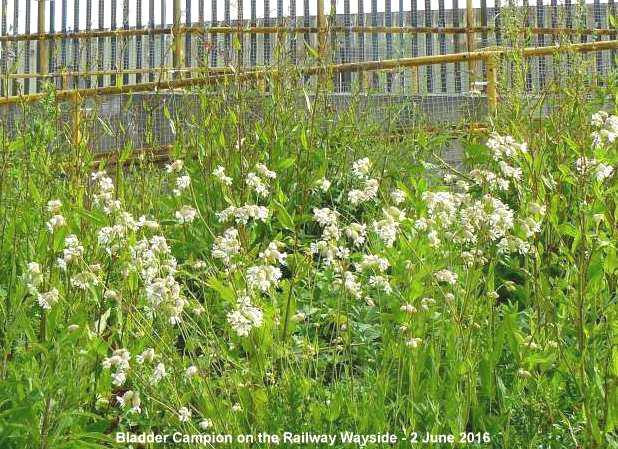
A close-up shot of
this lovely plant
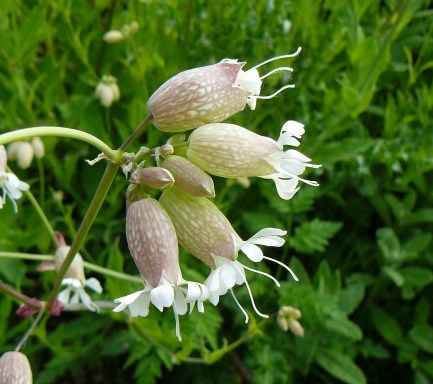
Of the insects I saw
my first 'thigh beetle' (Oedemera nobilis) of
the year on a buttercup flower and also my first
Cinnabar moth which paused for a photo.
Other
waysides
Moving on to the New Brighton Road Junction I found
much of the wayside had been recently mown by the
council, leaving just a patch of tall grasses in the
centre. Little of interest there.
The Christopher Way
wayside had received a similar treatment, though less
extensive. However, the mowing had removed all traces
of any Wild Clary on the wayside. The verge west of
the wayside where Wild Clary also grows had also been
closely mown, but all is not lost as they often come
later.
I came back through
Emsworth Recreation Ground where the area behind the
bowling club is looking very good with a rich mixture
of buttercups and grasses. I noted that Yorkshire Fog
was well in flower and I collected a few culms for my
desk display. Lesser Stitchwort was scattered around.
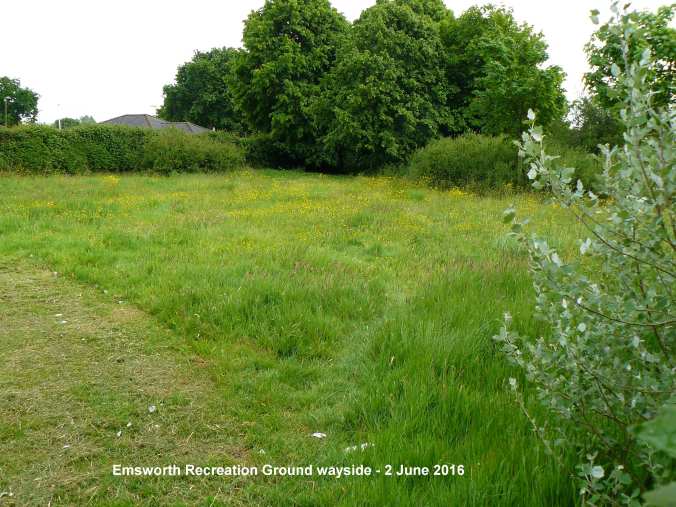
Langstone
sightings
Christopher Evans reports on today's outing with the
Havant U3A Birdwatching group.
"We saw a total of 33 species, starting by walking
down Wade Lane to Langstone, then over to the old
Oyster Beds on Hayling, before returning to the
Langbrook stream. Our best sightings were a Great
Spotted Woodpecker in the first field on the right in
Wade Lane and a Reed Bunting, appropriately enough in
the reeds by Langstone Mill pond. Also on the pond was
a lone Shelduck and the regular very pale female
Mallard with 10 ducklings. The Langstone swan family
were on the Langbrook stream by West Mill but have now
lost one cygnet.
After the rest of the group had headed homeward, I
continued on round Southmoor and over to Broadmarsh. I
had a good view of a Skylark sitting and singing on a
fence and then, back in Havant spotted a Water Vole
swimming north up the Langbrook Stream alongside
Langstone Technology park. "
WEDNESDAY
JUNE 1 - 2016
Slipper
Millpond
I cycled down
to Slipper Millpond mainly to check on the Great
Black-backed Gulls. I could definitely see three
chicks; previously I had only seen two and thought
they had lost one, but no, there were definitely
three. While I was there the male parent came in with
food for the chicks.
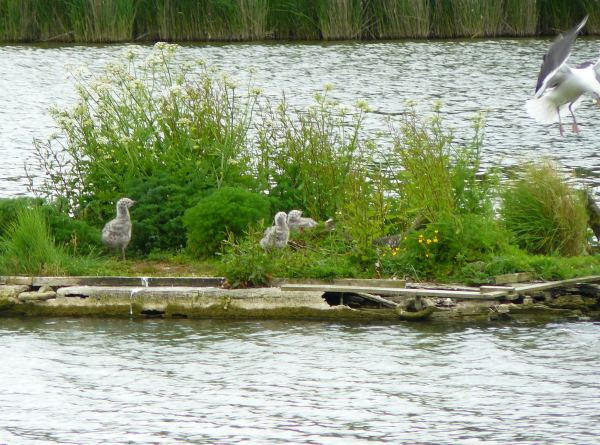
I was pleased to watch
the feeding process which involved the adult
regurgitating whatever it was he had caught for the
chicks to consume. The female meanwhile, sat patiently
on the other end of the raft, taking no part in the
feeding.
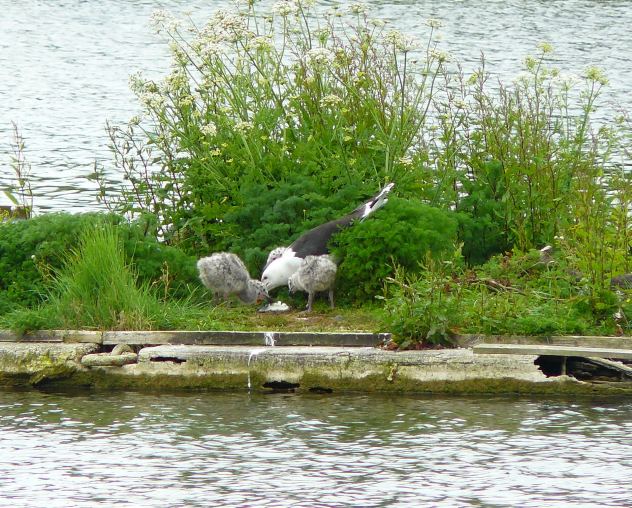
At the end, the male
slipped off the raft into the water for a wash.

The Swan family with 4
cygnets was in Dolphin Lake. No sign of any Coot
chicks which is not good news for them.
Brook
Meadow
I came back
through Brook Meadow. I waited patiently for 10 mins
on the Lumley Path footbridge looking at the pool with
camera at the ready, but saw nothing of the Water
Vole that has been seen here several times in the
past 2 weeks.
I did a recount of the
Ragged Robin on the Lumley area but found
slightly less than my earlier count on May 28 when I
had 154, so I shall leave that as the total for 2016.
As can be seen from the following chart this is the
best count since 2012. I have no idea why numbers of
this delightful plant vary so much from one year to
the next. There is no obvious change in the habitat or
the management of the area. Maybe, it is weather
related, who knows?
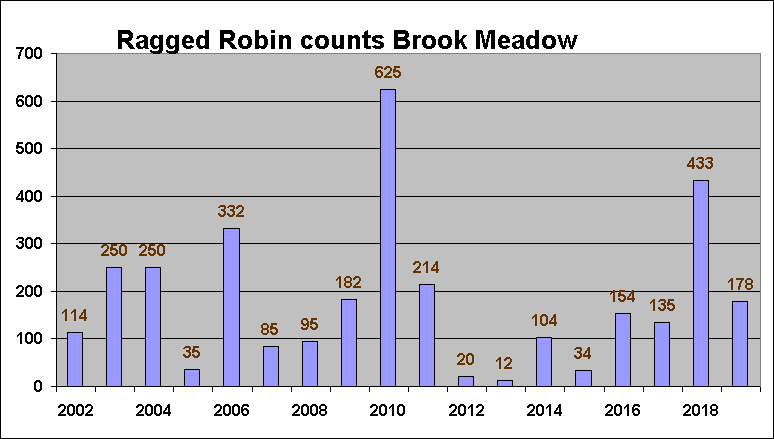
For details of the
Ragged Robin counts go to . . . http://www.brook-meadow.hampshire.org.uk/bm-plant-counts.html
I found my first
Hedge Bindweed flower (with no overlapping
sepals) on the north side of the Lumley area.
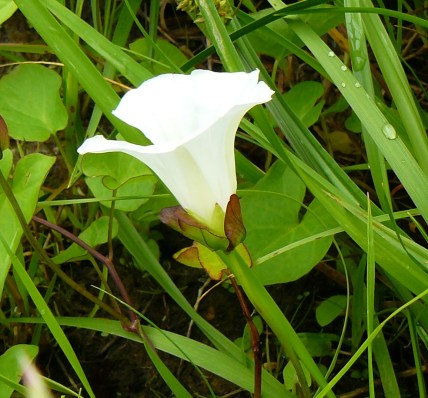
I checked the
Brooklime plants which were found by Jill
Stanley at the end of the casual path to the Lumley
Stream Grid Ref: SU 75153 06041. Nearby, I also found
a tiny little plant in among the reeds with tiny white
flowers which I am fairly sure was Hairy
Bittercress. I had a look for Blue Water-speedwell
that I usually find here, but there was no sign of it.
While counting the
Ragged Robin on the Lumley area I came across three
Southern Marsh Orchids - one pair growing
together at Grid Ref: SU 75132 06030 (see photo below)
- and one on its own at Grid Ref: SU 75130 06027.
I also checked the Southern Marsh Orchids on the main
orchid area on the north meadow and found the number
had increased to 9 plants in flower, with a cluster of
5 in one spot. This takes the overall total for the
meadow so far to 12.
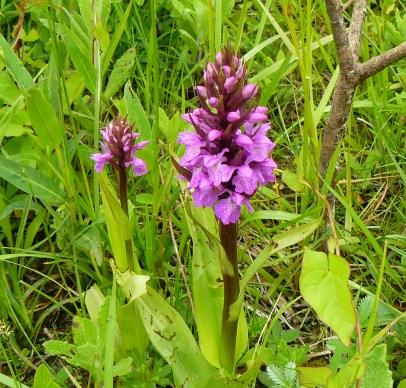
For
earlier observations go to . . May
17-31